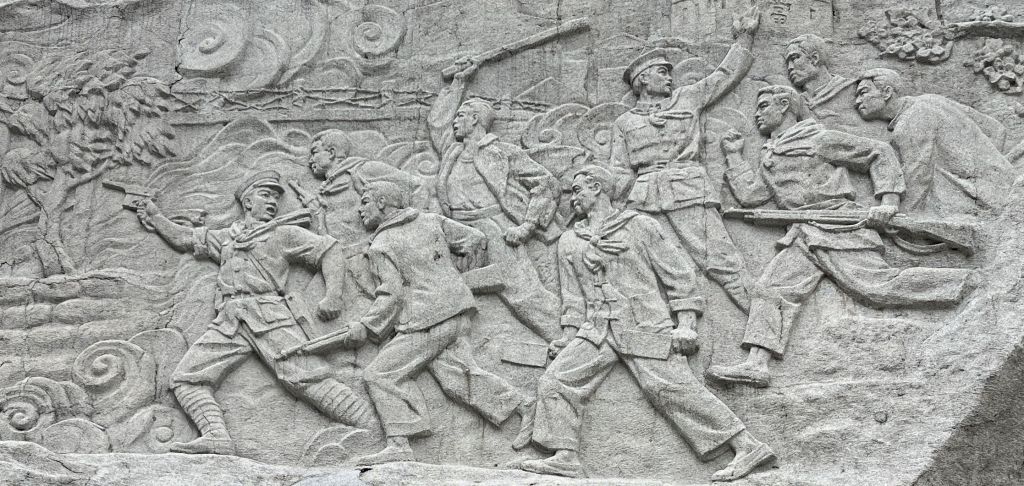
In Guangzhou last December to test out the new digital payment apps, I decided to visit the Martyrs’ Memorial Garden, built shortly before China’s alliance with the Soviet Union turned sour in the late 1950s, and commemorating the men and women who died in the preamble to the revolution. The park is scattered with memorials and pavilions, and dominated by a giant fist clutching a rifle, which looms over a mass grave of the dead from the Guangzhou Uprising of 1927.
Communist historiography recounts numerous squibs and wrong directions, momentary protests or strikes that threaten to break out into revolts. Each one is regarded with wistful indulgence, as a sort of stuttering of the starter-motor on regime change, before things eventually caught and the People’s Republic could start bootstrapping itself into existence. The Guangzhou Uprising was one of the last cul-de-sacs in revolutionary history – an ill-fated rebellion that fell apart soon after it started, mainly because it was ordered by overseas advisers who refused to listen to reason.
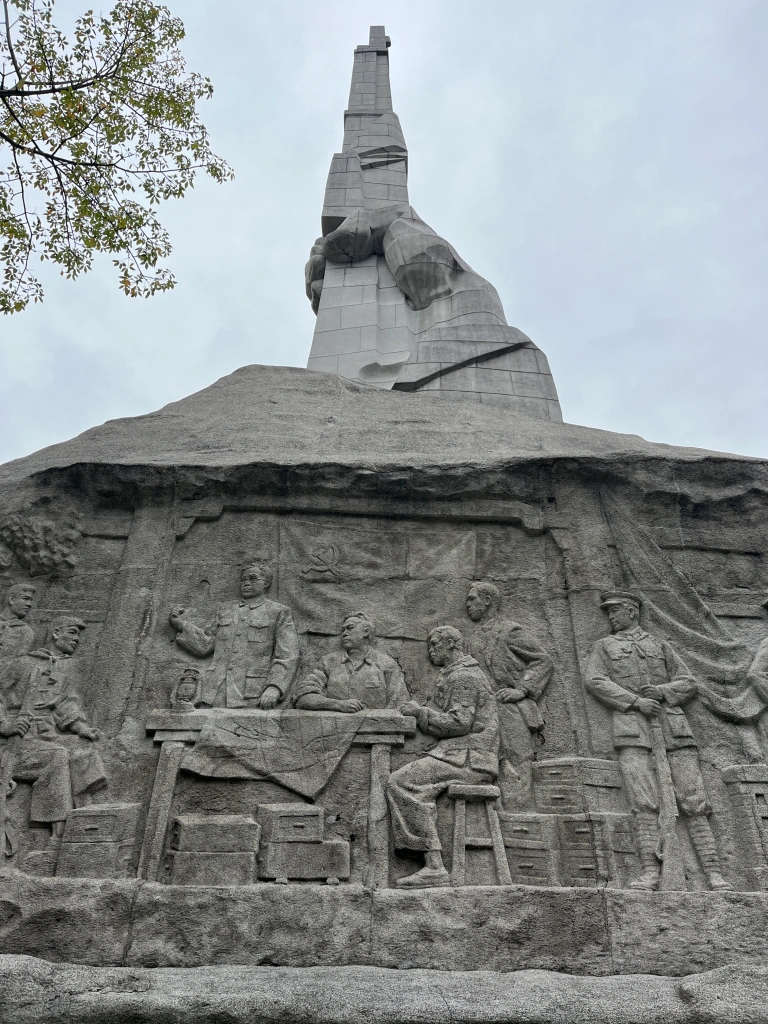
The carvings around the monument depict the initial battles of the revolt, tellingly with some of the soldiers armed with little more than meat cleavers and rocks. A moving sequence shows the brief and (as it turned out, misguided) celebrations, with the rebels congratulating themselves on the formation of the Guangzhou Soviet (the “Canton Commune”).
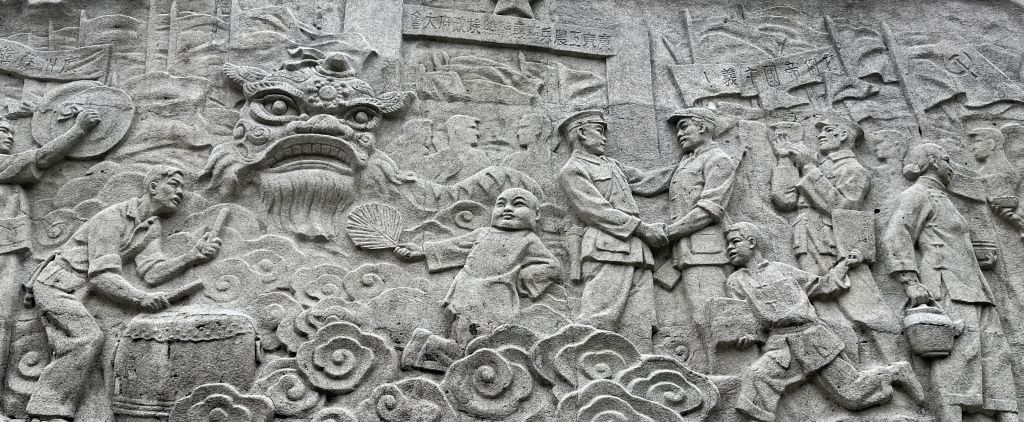
It was, however, terribly short lived. The rebellion had kicked off at the urging of foreign agents among local Communists, who had pressured them into proceeding with little guarantee of assistance. In spite of the protests of local commanders, who cautioned waiting a while longer for better men and materials, the rebellion only succeeded for the brief few hours that no retaliation was forthcoming. Zhang Tailei, the leader of the rebels, was killed as he drove in a car with a German Comintern agent, Heinz Neumann. His Canton Commune did not survive long after him, disbanding before a massive advance of six divisions of National Revolutionary Army soldiers.
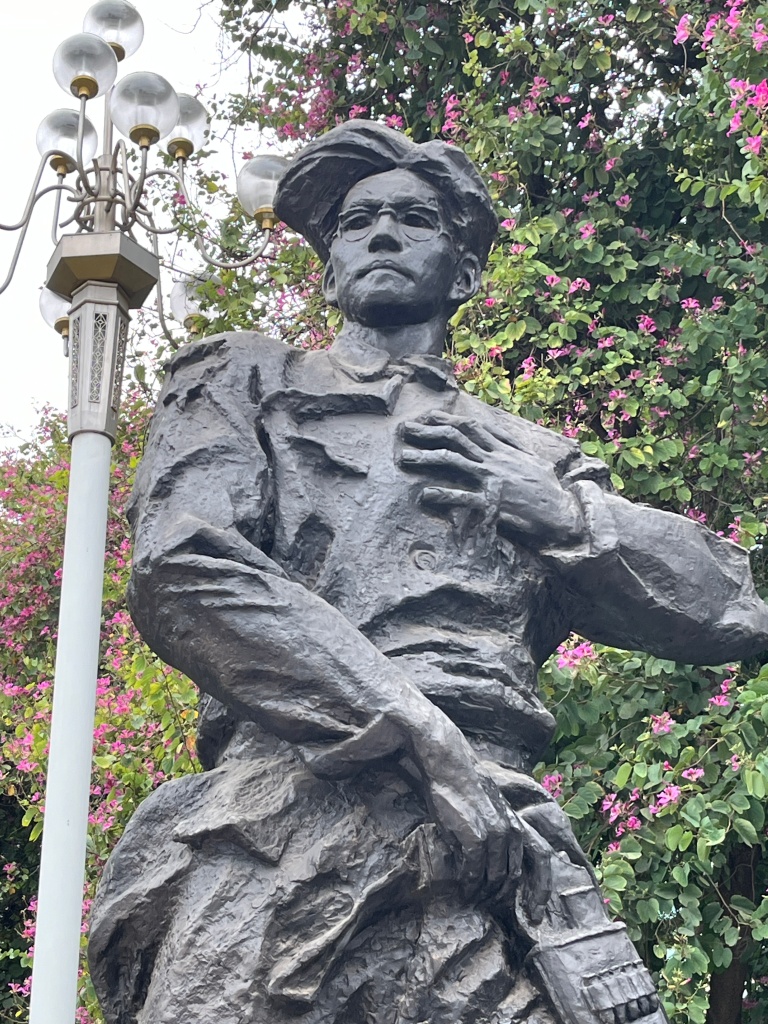
Zhang’s statue is one of the most striking in the set that lines the square in front of the park. His left hand clutches at his breast, seemingly to staunch a gushing wound, as he whirls to face an unseen foe, snatching his gun from its holster. I stumbled upon this pantheon of state-approved heroes on my way to the metro station, and stopped to take pictures of them and their memorial plaques, while police officers in a nearby van ate their packed lunches and stared at me quizzically. I am a sucker for Chinese public statuary, and always curious who gets memorialised and why in public spaces; these ones seem to have been technically outside the park grounds because some of them lived to fight another day.

Labour leader Chen Yu is depicted toting a Mauser, and sporting a doubled Chinese jacket, seemingly against the cold – I, too, was there on a December day, and wearing two jackets at once as I took his photograph in 2023. At the time the memorial garden was built in 1957, Chen had gone on to find fame far up the Communist Party ranks, as the Minister for the Coal Mining Industry, and was just about to be made governor of Guangdong Province, so you can bet he got a good pose.
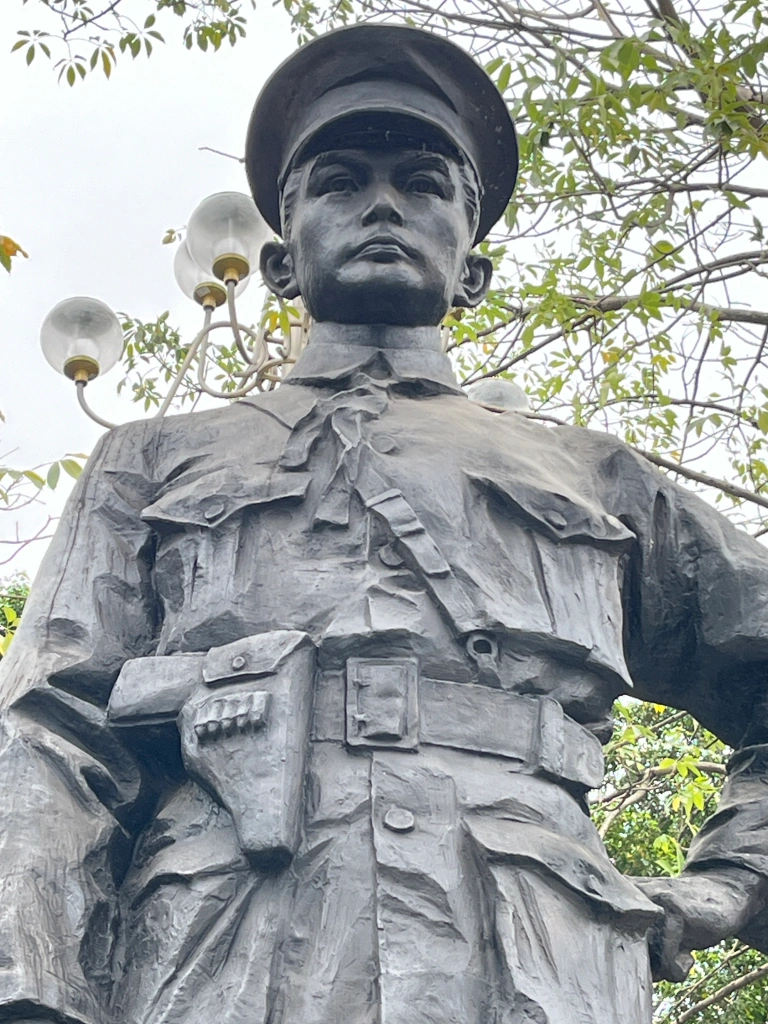
Ye Ting, the former Kuomintang officer who was forced to carry the can for the failed uprising, is celebrated in a much staider position, in his uniform. He would eventually be rehabilitated in time for the war against the Japanese, only to be imprisoned by his own people. He died shortly after his release in 1946, in a “plane crash” long believed to have been ordered by Chiang Kai-shek to prevent him returning to the service of the Communist Party.

Zhao Zixuan, another military officer, is depicted in a surprisingly demure fashion, his hand on his binoculars. A more sensationalist sculptor might have preferred to show him doing what made him famous in the uprising, which was the manufacture and deployment of most of the rebels’ home-made explosives. Most famously, in a stand-off against entrenched gunmen in the local police station, he flung burning planks doused with kerosene into the building in order to flush his enemies out. He would die the following year, single-handedly covering the retreat of his own men with a machine gun, after another failed uprising in Haifeng.

Nie Rongzhen is another military man depicted with his binoculars in hand, seemingly to emphasise his command role, both in the uprising and in his subsequent career. He would go on to lead a vanguard regiment on the Long March, would be a major participant in the Hundred Regiments Offensive of the war against Japan, and would eventually become the head of China’s nuclear weapons programme.

Zhang Tailei’s short-lived successor as the leader of the Guangzhou Uprising was Yang Yin, whose statue shows him handcuffed and defiant. Betrayed in Shanghai, he was arrested, tortured and executed in 1929.
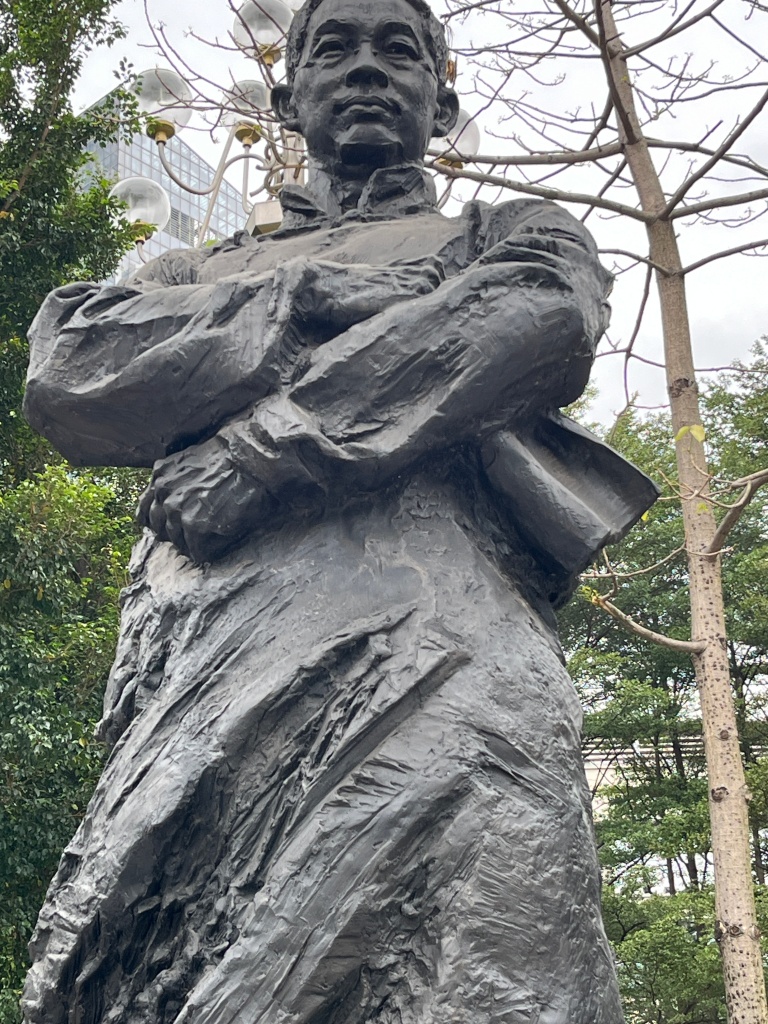
Uniquely among the statues, Yun Daiying looks rather smug and pleased with himself. At half past three in the morning, literally before the dawn of the Guangzhou Soviet, he was appointed its Secretary-General. After its fall, he would go on to become the editor of the Communist Party magazine Red Flag, a copy of which he seems to be clutching under his arm. He died in prison in 1930, in the words of his state encomium, “a drop of water in the long river of our struggle, a river that contains millions of such droplets.”
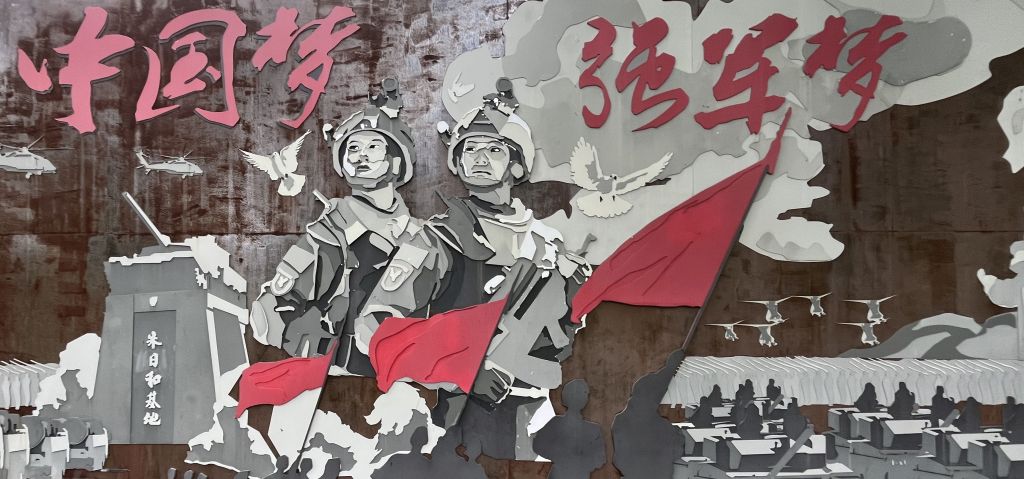
I found the Martyrs’ Memorial Garden to be a fascinating place – its tranquillity enforced by signage urging visitors to respect it as a war grave, and not to mess around at a site of national mourning. I’d hoped to drop into the Museum of Revolutionary History within the grounds, but it seemed to be in the middle of some sort of makeover on the day I dropped by. The Martyrs’ Memorial Garden does seem to be constantly upgraded and polished, most recently with a three-dimensional wall installation that deliberately linked the dead to the living, with a slogan evoking Xi Jinping’s speeches: “The Chinese Dream, A Strong Military.”
Jonathan Clements is the author of A Brief History of China. The Guangzhou Martyrs’ Memorial Garden has its own station (“Martyrs’ Park”) on line one of the Guangzhou Metro.

Your analysis and insight on these figures are very interesting! This really inspires me to take a closer look at every monument and piece of history next time I am in China.